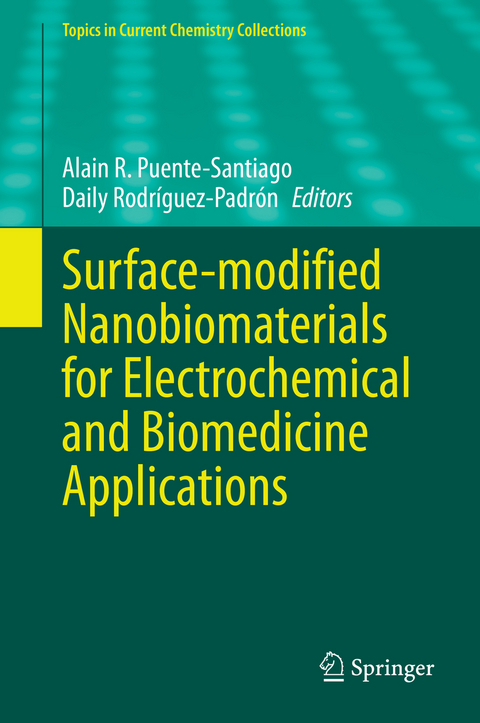
Surface-modified Nanobiomaterials for Electrochemical and Biomedicine Applications
Springer International Publishing (Verlag)
978-3-030-55501-6 (ISBN)
Each review within the volume critically surveys one aspect of that topic and places it within the context of the volume as a whole. The most significant developments of the last 5 to 10 years are presented using selected examples to illustrate the principles discussed. The coverage is not intended to be an exhaustive summary of the field or include large quantities of data, but should rather be conceptual, concentrating on the methodological thinking that will allow the non-specialist reader to understand the information presented. Contributions also offer an outlook on potential future developments in the field.
Alain R. Puente Santiago received his bachelor's degree in Nuclear Chemistry in 2007 from the Institute of Applied Science and Technologies (University of La Habana), Cuba. After this he gained his Master degree with distinction from the Institute of Materials Science for his research on the development of novel FETs microsensors. In 2010 he moved to Spain and started his doctoral work at the University of Cordoba working on the design of functional nano-interfaces. He obtained his PhD degree in Physical Chemistry with distinction in 2017. In the same year, he joined Rafael Luque's research group as a postdoctoral fellow. Currently, he is working as a Junior Professor in the Luque group working on research in Electrochemistry, Materials Chemistry and Chemical Biology. His main project is focused on the development of new bioinorganic functional nanomaterials for energy storage and catalytic applications. Daily Rodríguez-Padrón is a PhD student at the University of Córdoba (Group FQM-383). She received her Degree in Chemistry at the University of Havana, Cuba in 2013, and her Master Degree at the University of Córdoba, Spain in 2016. As part of her final year project for the Degree, she worked at the Center of Biomolecular Chemistry (Cuba), acquiring experience in carbohydrate synthesis. After finishing her undergraduate studies, she worked at the Center of Genetic Engineering and Biotechnology, in Cuba, for one year, focused on the synthesis of peptides. As part of her PhD investigations in the Group FQM-383 "Nanochemistry and biomass Valorization" she has published 15 research articles, focused on the design of nanomaterials through mechanochemical grinding processes, the functionalization of nanoparticles with proteins and their applications in catalysis, green chemistry, biomass valorization and electrochemistry.
TiO2 Nanomaterials in Photoelectrochemical and Electrochemiluminescent Biosensing.- DNA-Iron oxide nanoparticles conjugates: functional magnetic nanoplatforms in biomedical applications.- Magnetic Nanoparticles as MRI Contrast Agents.- Gold, silver and iron oxide nanoparticles: Synthesis and bionanoconjugation strategies aiming to electrochemical applications.- Quantum Dot bioconjugates for diagnostic applications
Carbon Nanotubes in Biomedicine.- Bioconjugated Plasmonic Nanoparticles for Enhanced Skin Penetration.- Proteins-based nanocatalyts for energy conversion reactions.
| Erscheinungsdatum | 30.07.2020 |
|---|---|
| Reihe/Serie | Topics in Current Chemistry Collections |
| Zusatzinfo | IX, 255 p. 81 illus., 67 illus. in color. |
| Verlagsort | Cham |
| Sprache | englisch |
| Maße | 155 x 235 mm |
| Gewicht | 571 g |
| Themenwelt | Naturwissenschaften ► Chemie ► Physikalische Chemie |
| Schlagworte | bioconjugated plasmonic nanoparticles • Biomedical Applications • bionanoconjugation • Magnetic Nanoparticles • nanobioarchitecrures • surface Functionalization • Surface-modified nanobiomaterials |
| ISBN-10 | 3-030-55501-1 / 3030555011 |
| ISBN-13 | 978-3-030-55501-6 / 9783030555016 |
| Zustand | Neuware |
| Haben Sie eine Frage zum Produkt? |
aus dem Bereich


